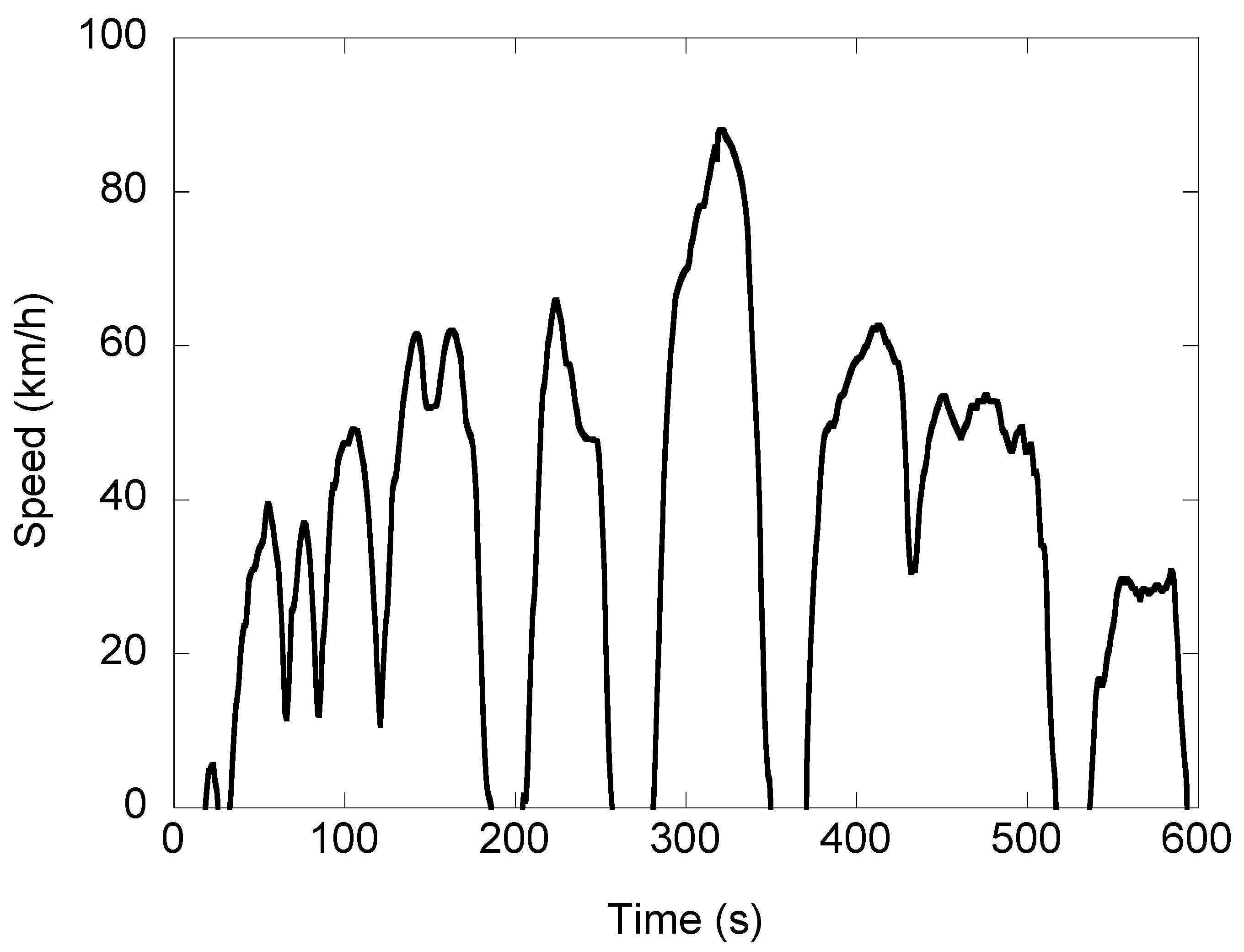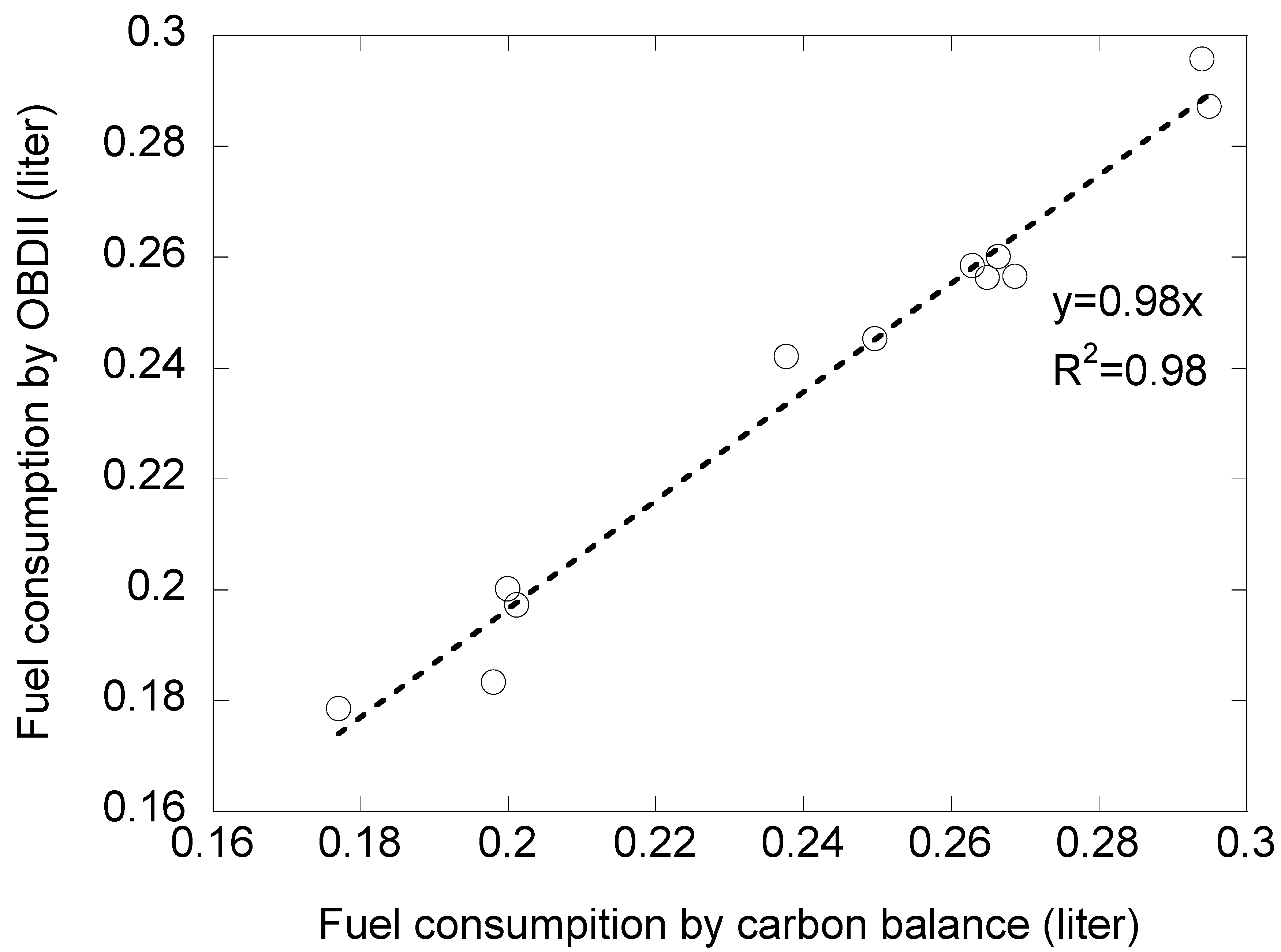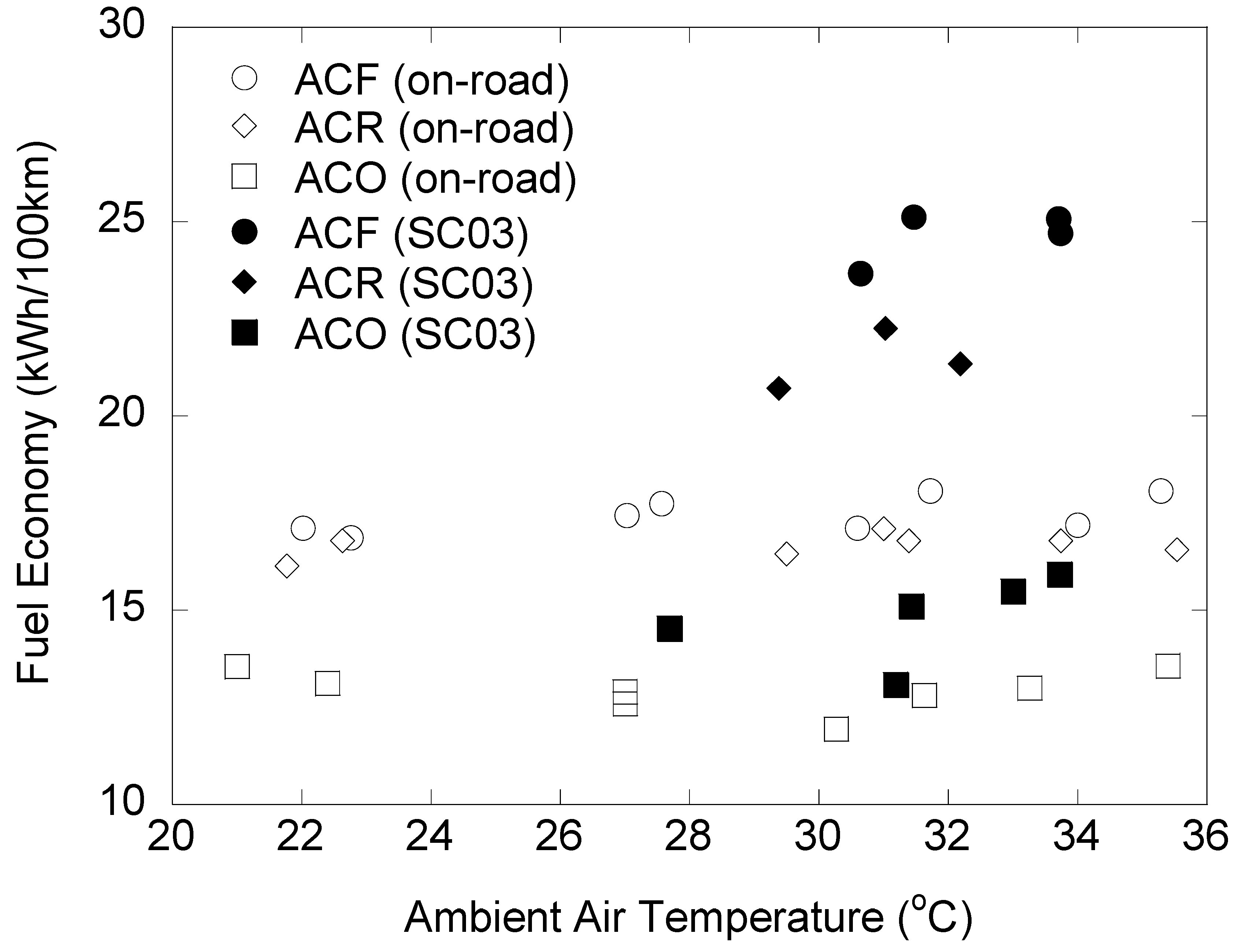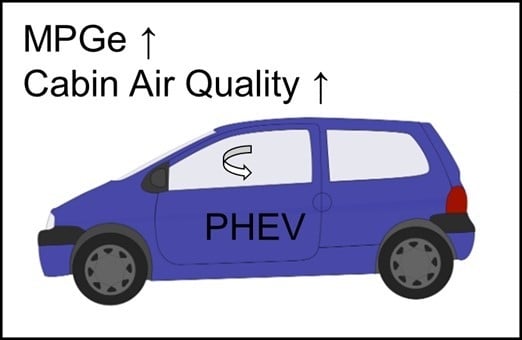Reducing Mobile Air Conditioner (MAC) Power Consumption Using Active Cabin-Air-Recirculation in A Plug-In Hybrid Electric Vehicle (PHEV)
Abstract
:1. Introduction
2. Experiment
2.1. Instruments
2.2. Vehicles
2.3. Tests
2.3.1. Fuel Economy and MAC Power Consumption Test in the Lab: SC03 cycle
2.3.2. On-Road Fuel Economy and MAC Power Consumption Test: Charge Depletion (CD) Mode on Local Surface Streets
2.3.3. On-Road Cabin-Air Quality Test: CS Mode on Highway
2.4. Calculation of Fuel Economy
3. Results and Discussion
3.1. Laboratory Test: SC03
3.2. On-Road Fuel Economy and MAC Power Consumption Test
3.3. In-Cabin Air Quality
3.4. Discussion
4. Conclusions
Author Contributions
Funding
Acknowledgments
Conflicts of Interest
Abbreviations
| ACO | Fresh mode with air conditioner (AC) off | BEV | Battery Electric Vehicle |
| ACR | Air recirculation mode with AC on | HEV | Hybrid electric vehicle |
| ACF | Fresh air mode with AC on | FTP | Federal Test Procedures |
| CS | Charge Sustaining | MPG | Miles per gallon |
| CD | Charge Depleting | PHEV | Plug-in Hybrid Vehicle |
| EAD | Electrical aerosol detector | SOC | State of charge |
| MAC | Mobile air conditioner | MPG | Miles per gallon |
| ICE | Internal combustion engine | MPGe | Miles per gallon equivalent |
| SFTP | Supplemental FTP | EPA | Environmental Protection Agency |
| OBD | On-board diagnostics | PID | Parameter identification |
| HVAC | Heating, ventilation, and air conditioning | CPC | Condensation particle counter |
| VERL | Vehicle Emission Research Laboratory | MAF | Mass air flow |
References
- EPA. Final Rule for Model Year 2017 and Later Light-Duty Vehicle Greenhouse Gas Emission Standard and Corproate Average Fuel Economy Standards. 2012. Available online: https://www.epa.gov/regulations-emissions-vehicles-and-engines/final-rule-model-year-2017-and-later-light-duty-vehicle#rule-summary (accessed on 2 October 2018).
- Holmen, B.A.; Sentoff, K.M. Hybrid-Electric Passenger Car Carbon Dioxide and Fuel Consumption Benefits Based on Real-World Driving. Environ. Sci. Technol. 2015, 49, 10199–10208. [Google Scholar] [CrossRef] [PubMed]
- Bharathan, D.; Chaney, L.; Farrington, R.B.; Lustbader, J.; Keyser, M.; Rugh, J. An Overview of Vehicle Test and Analysis from NREL’s A/C Fuel Use Reduction Research. In Proceedings of the Vehicle Thermal Management Systems Conference & Exhibition (VTMS-8), Nottingham, UK, 20–24 May 2007. CP-540-41155. [Google Scholar]
- Zhang, Q.; Meng, Y.; Creiner, C.; Soto, C. Air Conditioning System Performance and Vehicle Fuel Economy Trade-Offs for a Hybrid Electric Vehicle; 2017-01-0171; SAE International: Warrendale, PA, USA, 2017. [Google Scholar] [CrossRef]
- Nam, E.K.; Colvin, A.D. An Experimental Procedure for Simulating an SC03 Emissions Test with Air Conditioner on; SAE Technical Paper Series, 2004-01-0594; SAE International: Warrendale, PA, USA, 2004. [Google Scholar] [CrossRef]
- Sciance, F.; Nelson, B.; Yassine, M.; Patti, A.; Rao, L. Developing the AC17 Efficiency Test for Mobile Air Conditioners; SAE International: Warrendale, PA, USA, 2013; p. 0569. [Google Scholar] [CrossRef]
- U.S. EPA. Emission Standards Reference Guide. EPA SC03 Supplemental Federal Test Procedure (SFTP) with Air Conditioning. 2015. Available online: https://www.epa.gov/emission-standards-reference-guide/epa-sc03-supplemental-federal-test-procedure-sftp-air (accessed on 2 October 2018).
- Scales, B. VSD Compressor Control. 2013. Available online: http://www.airbestpractices.com/technology/compressor-controls/vsd-compressor-control (accessed on 2 October 2018).
- Shendge, S.; Tilekar, P.; Dahiya, S.; Kapoor, S. Reduction of MAC Power Requirement in a Small Car; 2010-01-0803; SAE International: Warrendale, PA, USA, 2010. [Google Scholar] [CrossRef]
- Srinivasan, D.; Phadke, P. Reducing AC Power Consumption by Compressor Downsizing on a Sports Utility Vehcile. In Proceedings of the International Refrigeration and Air Conditioning Conference Paper, West Lafayette, IN, USA, 17–20 July 2006; R048. pp. 1–7. [Google Scholar]
- Farrington, R.; Rugh, J. Impact of Vehicle Air-Conditioning on Fuel Economy, Tailpipe Emissions, and Electric Vehicle Range; NREL/CP-540-28960; National Renewable Energy Laboratory: Golden, CO, USA, 2000. [Google Scholar]
- Shete, K. Influence of Automotive Air Conditioning Load on Fuel Economy of IC Engine Vehicles. Int. J. Sci. Eng. Res. 2015, 6, 1367–1372. [Google Scholar]
- Jung, H.; Grady, M.; Victoroff, T.; Miller, A. Simultaneously reducing CO2 and particulate exposures via fractional recirculation of vehicle cabin air. Atmos. Environ. 2017, 160, 77–88. [Google Scholar] [CrossRef] [PubMed]
- Zhu, Y.; Eiguren, F.A.; Hinds, W.C.; Miguel, A.H. In-cabin commuter exposure to ultrafine particles on Los Angeles freeways. Environ. Sci. Technol. 2007, 41, 2138–2145. [Google Scholar] [CrossRef] [PubMed]
- Pui, D.Y.; Qi, C.; Stanley, N.; Oberdorster, G.; Maynard, A. Recirculating air filtration significantly reduces exposure to airborne nanoparticles. Environ. Health Perspect. 2008, 116, 863. [Google Scholar] [CrossRef] [PubMed]
- Jung, H. Modeling CO2 Concentration in Vehicle Cabin; 2013-01-1497; SAE International: Warrendale, PA, USA, 2013. [Google Scholar] [CrossRef]
- Grady, M.L.; Jung, H.; Kim, Y.C.; Park, J.K.; Lee, B.C. Vehicle Cabin Air Quality with Fractional Air Recirculation; 2013-01-1494; SAE International: Warrendale, PA, USA, 2013. [Google Scholar] [CrossRef]
- Monforte, R.; Lovuolo, F.; Rostagno, M.; Seccardini, R. New MAC Technologies: Fuel Efficiency Effect in Real Driving of the Air Intake Flap Management; 2015-01-1609; SAE International: Warrendale, PA, USA, 2015. [Google Scholar] [CrossRef]
- The International BMW Website. Automatic air Recirculation (AAR). 2017. Available online: http://www.bmw.com/com/en/insights/technology/technology_guide/articles/automatic_air_recirculation.html?source=index&article=automatic_air_recirculation/;2017 (accessed on 2 October 2018).
- Toyota Prius Operating Modes. ECO, Normal, PWR and EV. 2016. Available online: http://prius.wikia.com/wiki/Operating_modes_(ECO,_Normal,_PWR_and_EV)/;2016 (accessed on 2 October 2018).
- U.S. Energy Information Administration. California Leads the Nation in the Adoption of Electric Vehicles. Todays in Energy. Available online: https://www.eia.gov/todayinenergy/detail.php?id=19131/;2014 (accessed on 2 October 2018).
- Rugh, J.P.; Hovland, V.; Andersen, S.O. Significant Fuel Savings and Emission Reductions by Improving Vehicle Air Conditioning; National Renewable Energy Laboratory: Golden, CO, USA, 2004. [Google Scholar]
- Johnson, V.H. Fuel Used for Vehicle Air Conditioning: A State-by-State Thermal Comfort-Based Approach; SAE Technical Paper Series; 2002-01-1957; SAE International: Warrendale, PA, USA, 2002. [Google Scholar]
- Jung, H.; Silva, R.; Han, M. Scaling Trends of Electric Vehicle Performance: Driving Range, Fuel Economy, Peak Power Output, and Temperature Effect. World Electr. Veh. J. 2018, 9, 46. [Google Scholar] [CrossRef]
- Menke, J.; Scora, G. Mobile Energy Emission Telematics System (M.E.E.T.S.); University of California: Riverside, CA, USA, 2011. [Google Scholar]
- DeFries, T.H.; Sabisch, M.; Kishan, S.; Posada, F.; German, J.; Bandivadekar, A. In-Use Fuel Economy and CO2 Emissions Measurement Using OBD Data on US Light-Duty Vehicles; SAE Technical Paper Series; 2014-01-1623; SAE International: Warrendale, PA, USA, 2014. [Google Scholar] [CrossRef]
- OBD-II Resource. OBD-II Software Resource for Developers and Users. 2010. Available online: http://obdcon.sourceforge.net/2010/06/obd-ii-pids/ (accessed on 2 October 2018).
- Jung, H.; Kittelson, D.B. Characterization of Aerosol Surface Instruments in Transition Regime. Aerosol Sci. Technol. 2005, 39, 902–911. [Google Scholar] [CrossRef] [Green Version]
- Pham, L.; Jung, H.S. Alternative metrics for spatially and temporally resolved ambient particle monitoring. J. Aerosol Sci. 2016, 102, 96–104. [Google Scholar] [CrossRef]
- Green Car Reports. 2012 Toyota Prius Plug-in Hybrid Window Sticker Showing EPA Fuel Efficiency Ratings. 2012. Available online: https://www.greencarreports.com/image/100383903_2012-toyota-prius-plug-in-hybrid-window-sticker-showing-epa-fuel-efficiency-ratings (accessed on 2 October 2018).
- Hybrid Cars. 2012 Toyota Prius Plug-in Hybrid Review. 2012. Available online: http://www.hybridcars.com/toyota-prius-plug/;2012 (accessed on 2 October 2018).
- Khoury, G.; Clodic, D. Method of Test and Measurements of Fuel Consumption Due to Air Conditioning Operation on the New Prius II Hybrid Vehicle; SAE Technical Paper Series; 2005-01-2049; SAE International: Warrendale, PA, USA, 2005. [Google Scholar] [CrossRef]
- DieselNet. Emission Test Cycles: SFTP-SC03. 2013. Available online: https://www.dieselnet.com/standards/cycles/ftp_sc03.php (accessed on 2 October 2018).
- EPA. Sample Fuel Economy Calculations. 1987, Code of Federal Regulations 40 CFR Appendix II to Part 600. Available online: https://www.law.cornell.edu/cfr/text/40/appendix-II_to_part_600 (accessed on 2 October 2018).
- Silva, C.; Ross, M.; Farias, T. Evaluation of energy consumption, emissions and cost of plug-in hybrid vehicles. Energy Convers. Manag. 2009, 50, 1635–1643. [Google Scholar] [CrossRef]
- USNEWS. What Is MPGe? 2018. Available online: https://cars.usnews.com/cars-trucks/what-is-mpge (accessed on 2 October 2018).
- Durbin, T.D.; Karavalakis, G.; Russell, R.L.; Short, D.; Hajbabaei, M.; Villela, M. Aromatics Final Report; American Petroleum Institute: Washington, DC, USA, 2013. [Google Scholar]
- Xu, B.; Zhu, Y. Quantitative analysis of the parameter affecting in-cabin to on-roadway (I/O) ultrafine particle concentration ratio. Aerosol Sci. Technol. 2009, 43, 400–410. [Google Scholar] [CrossRef]
- Pham, L.; Molden, N.; Boyle, S.; Johnson, K.; Jung, H. Development of a standard testing method for vehicle cabin air quality index. SAE Int. J. Commer. Veh. submitted.








| Mode | PID | Data Bytes Returned | Description | Units | Formula |
|---|---|---|---|---|---|
| 21 | 81 | 18 | Battery Block Voltage-V01 | V | (A*256+B)*79.99/65535 |
| 21 | 81 | 18 | Battery Block Voltage-V02 | V | (C*256+D)*79.99/65535 |
| 21 | 81 | 18 | Battery Block Voltage-V03 | V | (E*256+F)*79.99/65535 |
| 21 | 81 | 18 | Battery Block Voltage-V04 | V | (G*256+H)*79.99/65535 |
| 21 | 81 | 18 | Battery Block Voltage-V05 | V | (I*256+J)*79.99/65535 |
| 21 | 81 | 18 | Battery Block Voltage-V06 | V | (K*256+L)*79.99/65535 |
| 21 | 81 | 18 | Battery Block Voltage-V07 | V | (M*256+N)*79.99/65535 |
| 21 | 81 | 18 | Battery Block Voltage-V08 | V | (O*256+P)*79.99/65535 |
| 01 | 0C | 2 | Engine RPM | rpm | ((A*256)+B)/4 |
| 21 | 7D | 3 | AC Power Consumption | hp | C*50*0.001341022089595 |
| 21 | 98 | 9 | Batt. Pack Current Value | amperes | (A*256+B)/100–327.68 |
| 01 | 5B | 1 | State of Charge | % | A*20/51 |
| 01 | 46 | 1 | Ambient Air Temperature | °C | A–40 |
| 01 | 0D | 1 | Vehicle speed | mph | A*6213/10000 |
| 01 | 10 | 2 | MAF air flow rate | grams/sec | ((A*256)+B)/100 |
| Parameters | Cycle/Road | |||||||||
|---|---|---|---|---|---|---|---|---|---|---|
| Lab SC03 | On-Road Surface Road | On-Road Highway | ||||||||
| Total distance (km) | 6.6 | 6.1 | 96.3 | |||||||
| Avg/max speed (km/h) | 34.8/88.2 | 38.1/65.5 | 71.6/118.3 | |||||||
| Vehicle mode | CS | CD | CS | |||||||
| AC mode | ACO | ACR | ACF | ACO | ACR | ACF | ACR | ACP | ACF | Amb. |
| Fuel economy (kWh/100km) | 14.8 | 21.4 | 24.7 | 12.9 | 16.7 | 17.5 | NM | NM | NM | NM |
| *AC power consumption (%) | 0.0 | 28.4 | 34.5 | 0.0 | 11.8 | 12.0 | NM | NM | NM | NM |
| Particle conc. (mm/cm3) | NM | NM | NM | NM | NM | NM | 0.08 | 0.22 | 0.55 | 1.05 |
© 2018 by the authors. Licensee MDPI, Basel, Switzerland. This article is an open access article distributed under the terms and conditions of the Creative Commons Attribution (CC BY) license (http://creativecommons.org/licenses/by/4.0/).
Share and Cite
Li, C.; Brewer, E.; Pham, L.; Jung, H. Reducing Mobile Air Conditioner (MAC) Power Consumption Using Active Cabin-Air-Recirculation in A Plug-In Hybrid Electric Vehicle (PHEV). World Electr. Veh. J. 2018, 9, 51. https://doi.org/10.3390/wevj9040051
Li C, Brewer E, Pham L, Jung H. Reducing Mobile Air Conditioner (MAC) Power Consumption Using Active Cabin-Air-Recirculation in A Plug-In Hybrid Electric Vehicle (PHEV). World Electric Vehicle Journal. 2018; 9(4):51. https://doi.org/10.3390/wevj9040051
Chicago/Turabian StyleLi, Chengguo, Eli Brewer, Liem Pham, and Heejung Jung. 2018. "Reducing Mobile Air Conditioner (MAC) Power Consumption Using Active Cabin-Air-Recirculation in A Plug-In Hybrid Electric Vehicle (PHEV)" World Electric Vehicle Journal 9, no. 4: 51. https://doi.org/10.3390/wevj9040051






